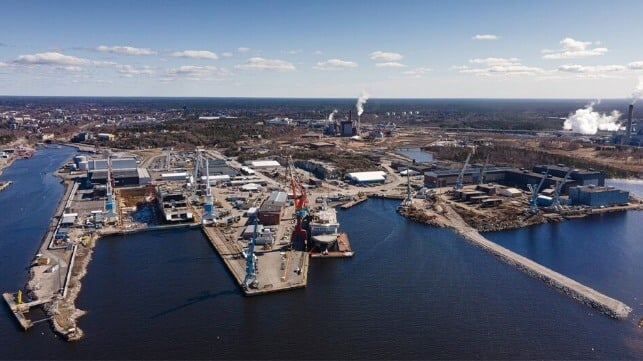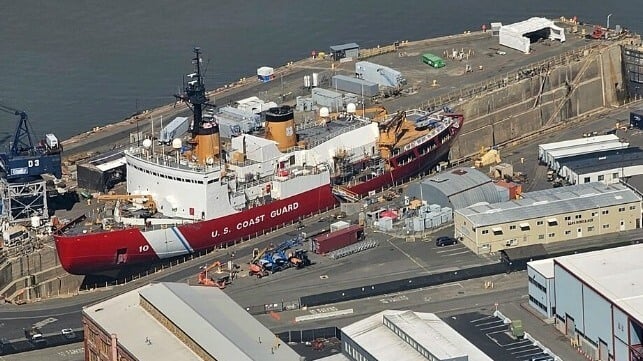Report: Finland is Frontrunner Negotiating for USCG Icebreaker Order

According to reports in the Finnish media, the country’s Rauma Marine Constructions shipyard is in negotiations with the United States to build a series of new medium icebreakers. A week ago, the USCG published a Request for Information for what were termed small icebreakers (370 feet in length) seeking shipyards that could deliver within three years of a contract award.
Finnish newspaper Helsingin Sanomat broke the news on Friday, April 18, saying it had confirmed the negotiations with three unnamed sources. Yle News has also picked up the story citing discussions in March between Finnish President Alexander Stubb and President Donald Trump. The newspaper reports just over a week ago Foreign Minister Elina Valtonen discussed the matter with U.S. Secretary of State Marco Rubio.
According to the report, the Rauma shipyard would build up to five medium-sized icebreakers, with the order valued at around €2.5 billion ($2.85 million). Helsingin Sanomat says that exploratory discussions are also underway regarding three larger vessels.
Rauma, located in southwest Finland on the Gulf of Bothnia, highlights on its website that three multi-purpose icebreakers were constructed in Rauma between 1993 and 1998 at the former Aker Finnyards and have been serviced at Rauma Marine. The yard also has experience with ice-strengthened hulls including for the ferry Aurora Botnia built in 2021.
The yard has been building ferries, including for Tasmania, and recently completed the hull for the first of four multi-role corvettes for the Finnish Navy. The first vessel is due to launch this spring and the second has started construction with the yard highlighted the vessels will be able to “operate in icy conditions.” The yard built a new enclosed construction hall for this project and has been positioning itself for expected orders to replace existing icebreakers in Scandinavia.
RMC, which was founded in 2014, is entirely Finnish-owned. It reports it currently has orders till 2028 valued at over one billion euros ($1.14 billion) as of October 2024.
Yle cautions in its report that the negotiations do not guarantee a deal. It says the U.S. Coast Guard has approached several shipyards around the world to assess their capacity to deliver icebreakers within 36 months. However, it also quotes Foreign Minister Valtonen who said after meeting Rubio, "We will likely have concrete news fairly soon."
A deal would be in keeping with the 2024 agreement between the United States, Canada, and Finland to jointly develop icebreakers. Canadian shipbuilder Davie was reported to be a driving force behind the agreement. Davie in 2023 acquired Helsinki Shipyard, which it was highlighted has built more than 50 percent of the global icebreakers. The Helsinki Shipyard was scheduled to build a new icebreaker for Russia, but the deal was blocked after the start of the war in Ukraine and that contributed to the financial collapse of the yard.
USCG Polar Star Starts Final Phase of Life Extension Program

The Coast Guard has initiated the final of five planned phases of the service life extension program (SLEP) for Coast Guard Cutter Polar Star, the service’s sole operational heavy icebreaker. Polar Star arrived at Mare Island Dry Dock in Vallejo, California, on March 30 to begin the remaining SLEP activities. The work is part of the In-Service Vessel Sustainment (ISVS) Program.
The SLEP is recapitalizing a number of major systems to extend the service life of the cutter and maintain polar ice-breaking capability until the polar security cutter fleet is operational. The Polar Star SLEP was designed to address targeted systems such as propulsion, communication, and machinery control systems for recapitalization. The USCG is undertaking the major maintenance program to extend the service life of Polar Star beyond its original design of 30 years.
Commissioned in 1976, Polar Star is the United States’ only heavy icebreaker capable of providing access to both polar regions. The Seattle-based cutter is 399 feet in length and 13,500 tons. The cutter's six diesel and three gas turbine engines produce up to 75,000 horsepower.
The life extension program began in 2021 in intervals timed between the vessel’s annual deployment to Antarctica. The current installment is the fifth and final phase planned in the program. The next generation polar icebreaker currently running six years behind the original construction schedule, with the shipyard Bollinger recently saying that completion of the first Polar Security Cutter is anticipated by May 2030 meaning Polar Star will remain active until age 55 or later.
Among the work scheduled during this period is a refurbishment in the two remaining zones of heating, ventilation, and air conditioning systems refurbishments. These zones will be refurbished with ventilation trunks, fans, and heaters to improve air circulation and maintain a comfortable living environment for the ship’s crew during extended deployments. The gyro repeater recapitalization will ensure that these critical pieces of navigation equipment are updated to modern standards, enabling safe navigation of the cutter. Ancillary pumps and motors are also targeted for recapitalization through the replacement of critical main propulsion and auxiliary systems with modern supportable units.
In addition, personnel from the Coast Guard Yard in Baltimore will be on site this summer, recapitalizing the sewage pumps and tank level indicators to ensure the crew can successfully monitor and manage sewage capacity while the cutter is executing its missions in ice.
Kenneth King, ISVS program manager, said “This phase represents a significant milestone for both Polar Star and the ISVS program, as our dedicated professionals ensure Polar Star meets its multifaceted missions in the polar regions until the arrival of the polar security cutter fleet.”
Last year’s effort targeted three systems aboard the vessel, including starting the refurbishment/ overhaul of the ventilation trunks, fans, and heaters that supply berthing areas of the ship. All the boiler support systems were also recapitalized/redesigned, including the electrical control station that is used to operate them. A complete recapitalization/redesign of the flooding alarm system also occurred from bow to stern to monitor machinery spaces for flooding.
In 2023, the program focused on improvements to shipboard equipment and numerous vital system upgrades for fire detection, communications, and monitoring water quality. Each year they also completed annual maintenance for the vessel.
Polar Star recently completed a 128-day deployment to Antarctica in support of Operation Deep Freeze 2025, the annual joint military logistics mission. This year’s deployment marked Polar Star’s 28th voyage to Antarctica in support of the joint military service mission to resupply and maintain the United States Antarctic Stations.
No comments:
Post a Comment